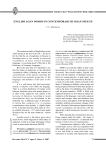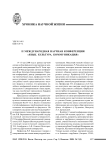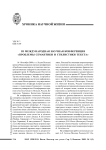Вестник Волгоградского государственного университета. Серия 2: Языкознание @jvolsu-linguistics
Статьи журнала - Вестник Волгоградского государственного университета. Серия 2: Языкознание
Все статьи: 1677
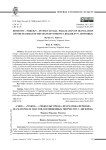
Статья научная
The article deals with the linguistic representation of the linguoculturological triad “domestic - foreign - intercultural” as part of the theory of reflective and translation turns developed by D. Bachmann-Medick. Globalization has transformed the principle of binarycategorization and mapped out the possibilityof their synthesis and formation of a third space of communication. The purpose of the study is to analyze and describe translation strategies and techniques used for the transfer of intercultural meanings that create a third space in the perception of the global recipientt, where neither basic, nor adaptive culture markers are preserved. The empirical basis of the study is represented with the original and translated texts of international artistic festivals, memoirs of Russian and foreign artists, as well as the verbal content of news online platforms dedicated to the 150th birth anniversary of S.P. Diaghilev. As a result of the analysis, three keystrategies for the translation of linguistic-and-cultural units have been identified: domestication, foreignization and intercultural mediation. Theyare interchangeablyused in the process of translating the Russian texts under consideration. However, owing to the communicative task of original texts - to convey the specifics of Russian culture and include national art in the world cultural fund, the strategy of intercultural mediation is the most frequentlyused one. This strategy is implemented through the use of Gallicisms in translated English and German texts, international vocabulary, and elimination of national and cultural specifics. It has been shown that a translator’s individual style is imposed on the systemic and cultural specifics of natural languages.
Бесплатно
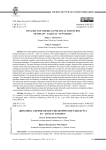
Dynamics of American political discourse of the 20th - early 21st centuries
Статья научная
The article addresses dynamics of conceptual space and communicative organization of the American political discourse in the 20th - early 21st centuries. The research objective is to identify transformations in the content of universal and nationally-marked concepts, as well as verbal modification of communicative strategies and tactics in the American political discourse of the periods under study. The main research methods applied are discourse, conceptual, semantic, and contextual analysis. The sampling corpus incorporates 662 public speeches of American presidents. The speeches under analysis belong to the ritual, orientational, and agonal genres of the political discourse. The main discourse-forming and nationally-marked concepts, features of the communicative structure of the American political discourse are established. The analysis of the metaphorical system as a way of realizing the intention in the American political discourse is carried out. The main types of conceptual metaphor, representing the discourse-forming concepts of the American political discourse are considered. The American political discourse conceptual space is more prone to transformations than its communicative structure in the studied timeframe. The nationally-marked concepts tend to be more dynamic than the universal discourse-forming concepts. The conceptual dynamism of the nationally-marked concepts manifests itself in the prevalence of the dominant features and the lacunarity at different stages of the American linguo-cultural community existence. The nationally-marked concepts components related to the historical and socio-cultural aspects of the speaking community life are brought into the open in the speeches of American presidents as transmitters of the national cultural values and role-status configurations in the political discourse of the 20th - early 21st centuries.
Бесплатно
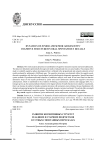
Dynamics of junior and senior adolescents’ cognitive structures in oral spontaneous recalls
Статья научная
This work analyzes dynamics in manifestation of cognitive structures in junior and senior adolescents. The data were obtained experimentally through oral recalls of educational texts on social studies. The purpose of the study is to identify cognitive sphere development that is reflected in the propositional and semantic elements of oral recalls produced by adolescents of different ages. The cognitive structures were detected within the cognitive-and-discursive paradigm with the help of psychological and psycholinguistic diagnostic approaches. Special functional syntax methods of predicate-and-actant elements of utterances analysis were used. It has been found out that the denotative maps of oral recalls performed by junior and senior adolescents demonstrate cognitive structures advancement, which is manifested in the evolution of thinking, consciousness, memory and language skills. As a teenager grows up, the actant-predicate relations in the logical scheme of recalls become more complex, in particular, there is an increase in number of complex semantic structures with connectors, taxis relations, the use of predicates with abstract and aspectual properties like resultative, procedural, dynamic, terminal, and statal. This article offers an insight into the work of adolescent’s cognitive system. The findings can be used in corpus and empirical studies.
Бесплатно
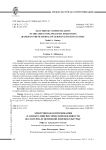
Статья научная
The article presents major ways of implementing linguistic politeness in electronic communication of the German linguocultural community. Following basic communicative principles of positive politeness, the authors analyze such e-mails speech acts as greeting, appeal, parting, congratulations, wishes, gratitude, that actualize strategies of positive politeness, or strategies of reconciliation in the virtual interaction of communicants. In German linguoculture the communicative strategies of reconciliation are the attention-and-care strategy, the strategy of using in-group identity markers, the strategy of exaggeration, the strategy of giving communicative gifts, the strategy of demonstrating intense interest; their implementation is supported with various means and methods of expressiveness, including contact appeals, adjectives, pronoun viel , modal verb mögen , performative verbs of wishes and gratitude, subjunctive mood, etc. It is stated that the communicative strategies of politeness are aimed at preserving the positive face of the addressee, that is, satisfying the needs of a person to show attention, care, interest, sympathy, love towards the addressee. It should be noted that study of the principle of politeness in email writing is viewed as a priority for German linguoculture, since communication via e-mail is one of the most popular and common ways of virtual written communication both at home and in business.
Бесплатно
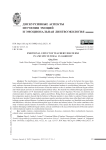
Emotional effect of teachers’ discourse in a multicultural classroom
Статья научная
The manifestation, meaning, categorization of emotions, as well as the factors that cause them, have cultural characteristics. To build successful intercultural interaction it is necessary to be aware of them. This study explores classroom discourse and emotions of international students in a multicultural classroom. Our goal is to determine what emotions the discourse of Russian teachers evokes in students from different lingua-cultures and which speech acts have an emotional perlocutionary effect. The material was obtained through a questionnaire with the participation of 70 international students (45 Chinese and 25 Algerian). We focus on emotions and emotional states of surprise, happiness, sadness and offense. Being drawn on qualitative and quantitative methods the comparative analysis showed that the behavior of Russian teachers is more likely to surprise Chinese students than Arab ones, besides Chinese students experience negative emotions and states more often than Arabs which may indicate a greater cultural distance. In relation to speech acts that evoke the emotions, we identified some similarities and differences, which are discussed through the type of culture and cultural values. The results contribute to the study of culture specific features of emotions in communication. They specify the factors that evoke emotions in students belonging to different lingua-cultures, and can contribute to the successful interaction of Russian teachers with international students in a multicultural classroom.
Бесплатно
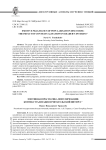
Emotive pragmatics of popularisation discourse: the impact of contextualisation on reader's interest
Статья научная
The paper adheres to the pragmatic approach to emotion processes and focuses on emotion- evocative communication. Its goal is to investigate the impact of contextualisation techniques, which employed by popularisation discourse to induce readers’ interest. The research is carried out in two ways, discourse-pragmatic and experimental. First, by adopting the sociopragmatic view of emotions and using methods of discourse analysis, the paper fleshes out a model of emotion-evocative communication, outlines contextualisation techniques, and introduces text materials. Second, by representing the experimental study, the paper assesses the interest-evoking effect of contextualisation. The experimental study involved 400 undergraduate students. We employed the scaling method (7-point bipolar scales) to measure participants’ attitude to generalised and contextualised text passages. The data analysis applied the Wilcoxon test, the Kolmogorov - Smirnov test, Spearman’s correlation coefficient, the linear regression, and the explanatory factor analysis. The comparing tests reveal that contextualisation promotes reader’s interest in the popularisation text. The findings suggest that contextualisation techniques make the text content more relevant to the reader. Personal relevance - as a kind of mediator - causes interest responses . Beyond that, it was found that that reader’s expectations about text strategies to presents knowledge construct interest- evocative communication. The findings demonstrate how communicative variables combine into the model of emotion-evocative communication.
Бесплатно
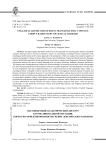
English academic discourse in translinguistic context: corpus-based study of lexical markers
Статья научная
The paper applies the Matrix method to an investigation into translinguistic features of English academic discourse that is serving worldwide a means of cross-cultural exchange between researchers with translingual skills. Based on the corpus approach to the comparison of the two corpora that comprise samples of professional academic writing in various fields of study (Art and Humanity, Natural and Social sciences), the paper seeks to identifyboth quantitativelyand qualitatively correlations in repertoire and frequencies of recurrent linguistic expressions between the native English-language and non-native (Russian) academic discourse performers. The corpora were investigated along with the use of lexical bundles, re-occurring lexical units, which were grouped into noun-based and preposition-based phrases with post-modifier fragments, verb-based phrases with any form of verb components. The data comparison points to a code-mixing trend at the syntagmatic layer, which is a translingual fusion of English words in accord with a mixture of syntagmatic relations typical of English and Russian variations of academic discourse. It was found that non-native writing does not reveal as much lexical flexibility as native writers do and to a large extent relies on formulaic expressions, most of which are not conventional for expert native academic writing. Native Russian writers use excessively noun-based phrases with abstract nouns and underuse noun phrases without prepositions. Verb phrases with that - and to- clauses are mainly characteristic of native professional writing whereas non-native writing employs patterns with active verbs and passive constructions. It was found that non-native writing lacks quantifying phrases and hedging expressions that mitigate the proposition.
Бесплатно
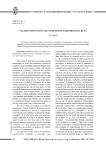
Evaluative connotations of proper names in Russian paremiology
Статья обзорная
Based on the study of Russian proverbs and sayings, thematic groups of paremias have been established, in which proper names have evaluative connotations; methods of education and types of estimated connotations of Russian anthroponyms are revealed
Бесплатно
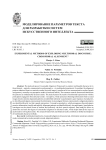
Experimental methods of exploring multimodal discourse: crossmodal alignment
Статья научная
The study advances Crossmodal Alignment Framework to explore multimodal discourse in its three formats - semiotic, communicative and perceptive - via multimodal experiment. It considers the alignment patterns obtained from two semiotic modes (text and image), transferred in two communicative modes (speech and gesture), sensed by two perception modes (visual and audial). The common research framework determines the patterns as modulated by discourse tasks. The study features the results of multimodal experiments with the participants engaged in three discourse tasks: 1) receptive, which presumes obtaining information from text and image stimuli; semiotic alignment patterns are identified indirectly via participants' gaze response; 2) productive, in which the participants communicate the information in monological format; communicative alignment patterns are identified directly via their speech and gesture; 3) receptive-productive, which presupposes the participants perceive information visually and audially; alignment patterns are identified directly via participants' gaze behavior contingent on the stimuli areas of interest and indirectly via their speech response. Data analysis allows to determine and scale the degree of crossmodal alignment to discourse tasks, which helps identify the input of each mode to solving these tasks. The research framework and obtained results contribute to further development of multimodal discourse methods.
Бесплатно
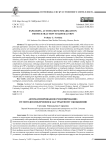
Exploring automated summarization: from extraction to abstraction
Статья научная
This paper provides a review of AI-powered automated summarization models, with a focus on two principal approaches: extractive and abstractive. The study aims to evaluate the capabilities of these models in generating concise yet meaningful summaries and analyze their lexical proficiency and linguistic fluidity. The compression rates are assessed using quantitative metrics such as page, word, and character counts, while language fluency is described in terms of ability to manipulate grammar and lexical patterns without compromising meaning and content. The study draws on a selection of scientific publications across various disciplines, testing the functionality and output quality of automated summarization tools such as Summate.it, WordTune, SciSummary, Scholarcy, and OpenAI ChatGPT-4. The findings reveal that the selected models employ a hybrid strategy, integrating both extractive and abstractive techniques. Summaries produced by these tools exhibited varying degrees of completeness and accuracy, with page compression rates ranging from 50 to 95%, and character count reductions reaching up to 98%. Qualitative evaluation indicated that while the models generally captured the main ideas of the source texts, some summaries suffered from oversimplification or misplaced emphasis. Despite these limitations, automated summarization models exhibit significant potential as effective tools for both text compression and content generation, highlighting the need for continued research, particularly from the perspective of linguistic analysis. Summaries generated by AI models offer new opportunities for analyzing machine-generated language and provide valuable data for studying how algorithms process, condense, and restructure human language.
Бесплатно
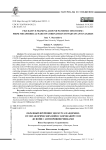
Статья научная
The current paper deals with metaphorical framing of the COVID-19 pandemic and public response to it in the public and media discourse. Being one of the most dramatic global challenges of the third Millennium, the COVID-19 pandemic spurred transformation in social order, economic/business relationships and dramatic growth in social anxiety and tensions, mistrust and discriminatory measures. It has inevitably found its reflection in language and related discursive practices, which rely heavily on discourse metaphors. When being systematically employed, they affect people's views of events, situations and decisions they subsequently make. The present paper focuses primarilyon the COVID-induced discourse changes that create new metaphorical framings and re-shape the familiar ones. The repertoire of elicited discourse metaphors framing the coronavirus discourse communicates the changing combating strategies referred to by the authors as globalist, nationalist and discriminatory. By drawing on specially compiled subcorpus of public and media texts, the paper reveals the conceptual and inferential structure of the concept of the COVID-19 pandemic and discusses the possible implications of activating various pandemic-related frames. The study stresses that the discursive construction of the coronavirus pandemic mirrors the dynamic nature of the pandemic itself as well as the measures to combat the insidious virus taken bynational governments, the spread of misinformation and fake news as well as the split in the society and discrimination of certain groups (vaccine deniers/anti-vaxxers). Acknowledging the prevalence of military metaphors in the pandemic-related discourse, the authors claim that metaphorical framing serves as a crucial conceptual tool to communicate the gradual transition from war on COVID-19 to war of vaccines and ultimately to war on out-groups (vaccine deniers, anti-vaxxers).
Бесплатно
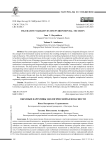
Figurative narratives of environmental security
Статья научная
The current paper presents a comprehensive overview of numerous, frequently divergent, views of the concept of environmental security and stresses the resulting ambiguity in its interpretations across various types of discourse. This calls for the need to provide an overarching explanation of what environmental security is to be able to tackle environmental issues in the years to come. Given the complexity and the abstract nature of the term, it is the effective use of language resources that can be helpful in making sense of the environmental security and relevant mechanisms to ensure it. The paper argues that figurative language serves as a pervasive cognitive mechanism in interpreting and foregrounding the major aspects of sustainable “communication” with and about the environment. The focal point of the paper is the authors’ urge to search for an apt metaphorical narrative encompassing various aspects of environmental security as a single metaphor is hardly able to cover a myriad of interdependent relations in the course of human-nature interaction. The analysis of the recurring discursive metaphors (military, medical, care) to refer to environmental security has revealed their downsides in promoting an adequate view of the current threats and, thus, the lack of public awareness of the emergency actions to save the planet.
Бесплатно
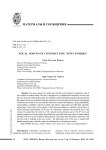
Focal points on constructing news stories
Статья научная
The issues stated in the article line with the current interest to pragmatic value of news releases in modern media. The news is thought to be a verbalized focal reflection of some event that was chosen by media professionals for setting the current information agenda. Having generated the opinions on the newsworthiness the authors present a set of values that may be used for measurement of relevance and clarity of an event reflection in the news content with frequency, clarity, predictability, unexpectedness, amplitude, cultural proximity, elite nations, elite people, personification, negativity among them. The novelty of the research is that the newsworthiness is checked with the focus to lexical (thematic) representation of the news in a diachronic approach: the empirical base of the research was taken from the archives of UK national and local media sources (18-20 th cent.) and implied comparison of lexical means that reflected an event itself and some values of human interest potential in the news stories written in defined periods. The article states the trend for dynamics in the way the event is reflected in the news stories - the information core of the story is merged with detailed reporting parts, and their content is conditioned by social and moral values.
Бесплатно
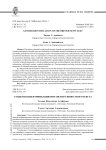
Gender identification of the British news text
Статья научная
The article is devoted to studying the impact of gender on speech behavior in mass media discourse. Gender peculiarities of English news text-formation are examined through coordination of various language means that belong to different levels of the language system with predetermined socio-cultural factors and psychological peculiarities attributed to man as a representative of masculine subculture, a communicative leader, characterized by autonomous thinking, logic, rationality, objectivity, lingua-creativity, reduced emotionality, and woman as a representative of feminine subculture, characterized by a greater degree of emotionality, empathy, cooperativeness. A number of gender parameters is listed, including content and structural features, specification / generalization of information, stylistically neutral / marked vocabulary etc. These parameters are being viewed as related with the categories of informativeness and expressiveness. It is determined that the features of the news text on the structural level manifest themselves in the selection of aspects of the events described, the organization of informative blocks. On the stylistic level gender specificity is expressed by linguistic realization of emotionality, evaluation, imagery. Gender parameters of the news text determine masculine and feminine styles of news text-formation and are included in the developed matrix of gender identification of the author of the news text. The psycholinguistic experiment allowed to verify the validity of gender parameters of the news text and to establish that the degree of sensitivity to its gender characteristics is determined by socio-cultural differences of native and non-native speakers of English.
Бесплатно
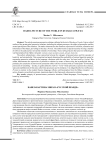
Habeo-картина мира в "Русской правде"
Статья научная
В статье рассматриваются посессивные отношения, отраженные в тексте «Русской Правды». Дается представление о прототипических посессивных отношениях, включающих субъекта-посессора, объект обладания и второго участника ситуации. Охарактеризованы посессивные ситуации приобщения, отчуждения и наследования объекта, преобладающие в «Русской Правде». В анализируемом тексте отмечена особая востребованность для передачи отношений собственности ряда глаголов, восходящих к одному корню, отражающему восприятие мира с позиций Habeo: изымати, емати, поимети, пояти, прияти, имати и др. Обоснована тесная связь категории посессивности с понятиями локативности и экзистенциальности, которая во многом определила наличие различных языковых средств для экспликации посессивных отношений: иметь-конструкций и быть-конструкций. С привлечением этимологических данных показана специфика выражения данными конструкциями отношений посессии, делается вывод о связи глагола иметь с «начальной точкой» владения, имения чего-то в своей сфере (брать, хватать), в отличие от глагола быть, который выражает прежде всего экзистенцию, состояние и становление этого состояния, но не посессию и ее начало. Утверждается, что в «Русской Правде», в отличие от современного русского языка, находит отражение восприятие мира с позиций Habeo: активное, динамичное, деятельностное владение одушевленным, неодушевленным объектом в рамках отношений собственности.
Бесплатно
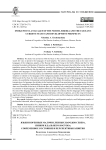
Статья научная
The study was carried out with the focus on the current issues of sociolinguistics related to the search for ways to preserve the languages of small peoples. The article systematizes data on the state of the languages of the indigenous peoples of the Russian Federation living in the North, Siberia and the Far East, presented in modern publications of historians and linguists, and the documents that reflect the results of the 2010 population census of the Russian Federation, considers the influence of sociolinguistic factors on the language situation in these territories. Having analyzed the world experience of legal language legislation on preserving the cultures and languages of small peoples, the authors attempted to apply some global criteria to the Russian legislation and socio-economic practice and identified socially significant criteria for establishing the language situation in relation to the languages of the indigenous peoples of the Russian Federation living in the North, Siberia and the Far East: the total number of speakers of the language, the use of the language in the education system, the availability of educational and methodological materials for teaching, the factor of inter-generational transmission of a language, the attitudes to the functional benefits from practicing the language among its native speakers. By compiling a methodology for categorizing the language survival type five prototypes of the language state were identified on the basis of statistical data: safe; relatively safe; endangered; critically endangered; close to extinction or dead languages. The authors offered a set of extralinguistic criteria for obtaining objective data on the state of the language and made a supposition that despite the evidence that the languages of the indigenous small-numbered northern peoples of the Russian Federation, with rare exceptions, are on the verge of extinction, significant efforts are being made by the government of the country and the indigenous northern peoples themselves to preserve these languages.
Бесплатно
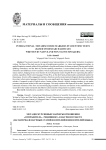
Статья научная
The present research investigated textual representations of writer-reader interaction in academic writing. The focus of the study was on the use of metadiscourse markers, i.e., stance and engagement markers, in applied linguistics research articles (RAs) published in English and Persian, the former written by Persian and English-speaking researchers, and the latter by Persian-speaking researchers. A cross-cultural analysis of RAs revealed similarities and differences in how academic writers express their stance and interact with their readers. Among the stance markers, hedging devices were found to be more frequently used in English RAs for expressing the authors’ position, regardless of their native language. Persian RAs, on the other hand, predominantlyused attitude markers for that purpose. In terms of the engagement markers, directives were the most prominent linguistic features employed by the writers in their native language. However, theywere significantly less frequent in English RAs written by Iranian scholars. Compared to native English writers, Iranian writers showed a slightly stronger tendency to use reader pronouns and personal asides in their native language. This study reinforces the impact of the writers’ linguistic and contextual awareness of the first- and second-language academic discourse conventions on the establishment of a successful writer-reader interaction and effective communication of arguments in academic writing.
Бесплатно

